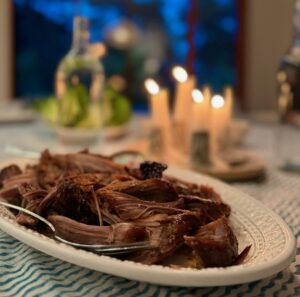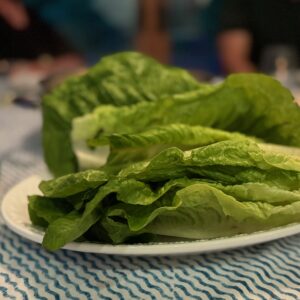I am an aspiring vegetarian. I love the idea of eating low on the food chain, and I think there are considerable ethical arguments for doing so (not to mention how nice it would be to lower my cholesterol). But when I come across the kind of pork that Rebecca Scanlan raises and sells at the Wellfleet Farmers Market, my aspirations fall apart, and I have to quickly rethink my positions so that they line up with my taste buds.
Here’s where I usually land: I try not to eat a lot of meat, and I try to source it from somewhere close, so that it hasn’t had to use a lot of precious natural resources on its journey to the table. In a perfect world, I want to know the farmer who raised my dinner and know that it was raised well. For me, that changes the equation.
Scanlan raises the pigs at Pleasant Lake Farm in Harwich — a place she shares with her partner, Skipper Lee. “I’m the farmer, he’s the tugboat captain,” she says. The pigs are a cross between Berkshires and Mangalitsas, which Modern Farmer calls “the hairy breed that’s the Kobe beef of pork.” She’s got a boar named Kyle, I learned, and a sow named Sweetie, and the pigs are raised on a hormone- and antibiotic-free diet that includes gleanings from her vegetable fields and apples from a friend’s nearby orchard.
After the Wellfleet Farmers Market closes for the season, Scanlan sells her meat at the markets in Chatham and Falmouth, which continue through the winter. In the slower cold months, she also sells direct from her farm.

The first time I stopped at Scanlan’s stand, I bought a pork shoulder and some sausages. I am hesitant to write about the sausages because I am afraid that there will be a run on them. They are divine, even if “sausages” is a little bit of a misnomer — they are more like pate.
When I make pork shoulder, I turn to a David Chang recipe I have used many times. It is a classic, not only because it is so delicious but also because it is so stupidly easy. Essentially, it is the recipe for Bo Ssam, one of the Korean-inflected recipes from the New York restaurant, Momofuku, that put Chang on the map. The recipe is deceptively straightforward: it involves not much more than a beautiful cut of heavily marbled meat, cured for 24 hours with a rub that consists of equal parts kosher salt and sugar. That’s more or less it. The pork roasts low and slow, and dinner is insanely good.
Chang’s recipe proposes lots of fixings and two different sauces to go with the meat, but, honestly, none of them is critical, and the template — because that is the best way to think about this recipe — is infinitely flexible and variable. If I were to make only one sauce, I would choose the vinegary one to cut the unctuousness of the pork. A little heat (chili crisp or even sriracha) is good as well. In a pinch, I’ve used sauce from a jar (I like the jarred sauces from Chang himself, which are available sometimes at a Stop & Shop near you). I’ve also served the roast with very little sauce at all. It’s moist and perfect, and really just a little lime juice is all it needs.

I do think something crunchy is essential to go with it. (Like Samin Nosrat says, think “salt, fat, acid, heat,” and you will do fine.) My favorites are julienned cucumbers and whole romaine lettuce leaves, which you use to roll everything together, like a taco. Cilantro is good, too, if you feel like washing it and pulling the leaves off the stems. Sometimes I do. And I make rice, of course.
With this good meat, slow-roasted, even the salt-and-sugar rub is not crucial, which raises the question of whether the resulting dinner should still be attributed to David Chang. Attribution notwithstanding, later in the summer, when I bought my second pork roast from Scanlan, I did very little to it, and it was equally delicious.
I feel I must mention that one of the accompaniments in Chang’s original recipe is oysters, which is an interesting idea for all of us who live anywhere near Wellfleet. But I’m not convinced. I like oysters, and I like pork, but I draw the line at eating them at the same time — maybe as a nod to my orthodox Jewish grandparents, who might have looked discretely away from the occasional ham sandwich, but ham and cheese? The idea of combining pork and oysters would have made Miriam and Jacob’s heads explode. That said, my reasons are purely preferential, but have at it, if you will.
Scanlan and I discussed the ridiculous ease of a slow-roasted pork shoulder, and she lamented that people are intimidated by it when in fact it is almost impossible to mess up. Feel free to pretend you have been sweating over a hot oven all day. Your dinner will taste like you did.
LAZY PORK ROAST
Makes 6-8 servings
For the roast:
1 pork shoulder, 4-5 lbs (bigger is fine, too)
½ cup sugar
½ cup kosher salt
A vinegary dipping sauce:
1½ tsp. soy sauce
1½ tsp. rice vinegar
¾ tsp. sherry vinegar
1½ tsp. mirin (rice wine)
1-2 tsp. chili oil, or to taste
Accompaniments:
Thin-sliced scallions
Cilantro leaves, washed and dried and pulled from the stems (don’t chop)
Lime juice
White rice
Julienned cucumbers
Romaine lettuce (Bibb works, too)
- The day before you plan to cook the pork, mix together the white sugar and the kosher salt, and rub the meat with it on all sides. Place it in a well-sealed container or a plastic bag in the fridge and turn it over occasionally.
- Preheat the oven to 250° Brush excess salt and sugar from the pork, place it in a roasting pan, and put it in the preheated oven. After about an hour, baste it from time to time.
- After 6 hours, the roast should be tender, and soon thereafter should begin to fall apart. When it has done so, remove it from the oven and let it rest long enough to either pull it apart or slice it thinly. On occasion, depending on the particular piece of meat, the falling apart doesn’t happen. In this instance, the thin slice is good.
- Serve with rice and other accompaniments; rolling servings of pork and all the rest into lettuce leaves is one way to do things.



